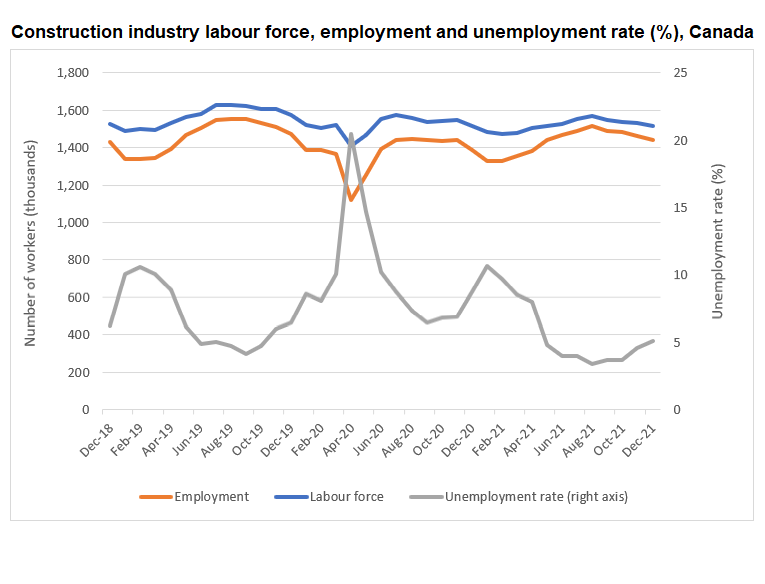Construction’s seasonal slowdown continued in December.
The latest Labour Force Survey (LFS) data issued by Statistics Canada on January 7 shows a drop in industry employment of 22,900 workers (-1.6%) for the month. December marks the fourth month in a row in which construction has shed jobs; a trend mostly attributable to the limited seasonality that still exists in some segments of the industry.
Statistics Canada collected data for its December LFS during the week of December 5 to 11. The seasonally adjusted employment data for all industries recorded at the time showed a jump in employment of 55,000 (+0.3%). The overall national unemployment rate was little changed at 5.9% in December. That figure was slightly above its pre-pandemic February 2020 level (5.7%), and within 0.5 percentage points of the record low of 5.4% observed in May 2019.
Public health measures in place across the country during the reference week were largely similar to those in place in November and were among the least restrictive seen during the pandemic.
Critically, the widespread emergence of the Omicron COVID-19 variant, and any resulting adjustments to public health measures, occurred after the December reference week.
Construction metrics surpass 2020 levels, but remain short of 2019 highs
Construction employment in December 2021 was 3.9% higher (+54,600 workers) than a year previous. However, the industry remains 2.4% short (-35,600 workers) of 2019 levels, when it reached record totals.
Every province except British Columbia (+1.8%) and Prince Edward Island (unchanged) saw construction employment decline in December.
Newfoundland and Labrador experienced the steepest decline at just under 11%, with Nova Scotia (-9.5%) and New Brunswick (-5.1%) also seeing sharp drops. The remaining provinces all reported month-to-month declines of less than 3%.

Compared with December 2020, employment levels were notably lower in British Columbia (-3.8%), Nova Scotia (-3.4%), and (-0.7%) Manitoba, and significantly higher in Quebec (14.2%), New Brunswick (14.2%), Saskatchewan (12.2%), and Newfoundland and Labrador (9.3%).
The remaining provinces reported annual employment gains of 6% or less.
Construction’s national unemployment rate increased by 0.5 percentage points to 5.1% in December, but remains 3.6 percentage points below December 2020 levels and 1.4 points below 2019 levels. Most provinces saw increases in their industry unemployment rates in December, with only Nova Scotia, Alberta, British Columbia, and Ontario reporting decreases.
Prince Edward Island experienced the largest rise in percentage points (+9.3%), despite employment remaining unchanged from November levels. Newfoundland and Labrador also reported a notable rise – of 5.2 percentage points – from November levels. The remaining provinces reported gains in the unemployment rate of less than 4 percentage points.
Finally, national hours worked increased in December, rising 1.9% from November levels. Newfoundland and Labrador (-12.9%), Ontario (-2.2%), and Alberta (-1.2%) were the only provinces to report month-over-month declines. British Columbia reported a sizeable increase of 14.5%, while the other provinces reported more modest gains.
Compared to December 2020, total hours worked increased 6.6%. Hours have yet to return to pre-COVID levels but are within 1.5% of those reported in December 2019.


Construction Key Indicators
